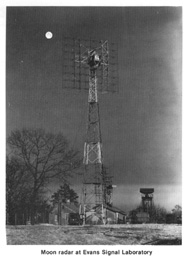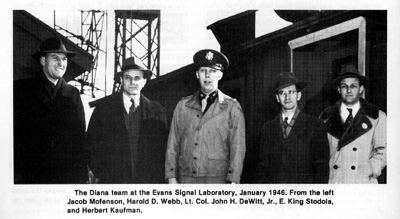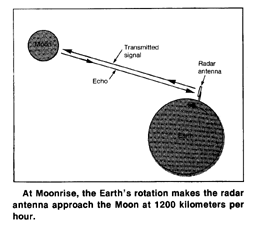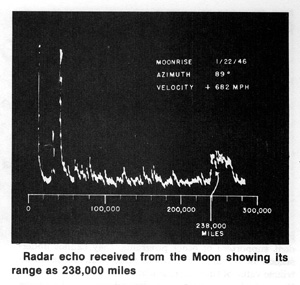"This is WSM," was an announcement familiar to millions of mid-continent Americans in the years prior to World War II. Radio was king; television was in the future and WSM, at Nashville, Tennessee, was one of the nation's most powerful clear-channel broadcasting stations.
The chief engineer of WSM was "Jack" DeWitt, a graduate of Vanderbilt University in Nashville. Although radio was Jack's first love, astronomy was his second and he had often wondered if it would be possible to beam a radio wave to the moon and receive an echo back. Perhaps . . — but it seemed like an impossible dream.
When World War II broke out, Jack left WSM and by 1943, at age 37, had become Lt. Colonel John H. DeWitt, Director of the Evans Signal Laboratory of the U.S. Army at Belmar, New Jersey, with responsibility for radar development.
Radar is an acronym. It stands for RAdio Direction And Range. It is also a palindrome (spelled the same forwards and backwards). Developed during the war, radar can "see" in the dark and through clouds and fog. Its principle is as simple as clapping your hands in a canyon, a large room or in a cave. The clap sends out a sound wave and the walls reflect back an echo. The further away the walls, the longer the wait or delay for the echo. Instead of a clap of sound waves, a radar sends out a pulse of radio waves from an antenna. A receiver then listens for echoes bouncing back from some object or objects in the path of the radar's beam. The echo delay time is a measure of the distance or range of the object. Turning the antenna for maximum echo response gives the direction of the object. In practice a succession of pulses are transmitted with listening done in the intervals between.
Although moon echoes may have crossed Jack's mind during the war, there was urgent business at hand. At the war's end in August 1945, however, priorities changed and Jack had his chance. With some other engineers at the Evans Laboratory, he organized Project Diana, named after the goddess of the moon, with the intent of trying a moon bounce.
The moon was larger than any object previously detected by radar but it was also much farther away. The average distance of the moon is about 380,000 kilometers so the time for a radio signal to reach the moon is about 1 1/4 seconds and the time for the return is another 1 1/4 seconds. Thus, the expected echo should arrive back 2 1/2 seconds after the pulse or "main bang" was transmitted.
Jack and his group began to assemble components from many different radars. They had calculated that only a very special combination of equipment would do the job. The transmitter they chose was a 3 kilowatt unit while the receiver was a very sensitive type. The wavelength of 2.7 meters, which they selected, was short enough, they believed, to penetrate the ionosphere or charged particle layer surrounding the earth above the atmosphere.


For the antenna they combined two Army SCR-270 radar antennas making a "billboard" array of 64 half-wavelength dipoles measuring 12 by 12 meters and mounted it on a 30 meter tower at the edge of a bluff overlooking the Atlantic Ocean near the Shark River inlet on the Evans Laboratory grounds. This array should increase the power radiated toward the moon by a factor of 64 giving the same effect as 192 kilowatts in a single dipole. They connected a switch to the antenna so that after a pulse had been sent, it could be thrown to connect the antenna to the receiver.
 For weeks Jack and his group sent pulses and listened but there was no echo. They did not listen at the same wavelength as they transmitted because at moonrise they were approaching the moon by as much as 1200 kilometers per hour due to the earth's rotation. Therefore, they tuned the receiver to a somewhat higher frequency to compensate for the doppler shift. This is the same effect as the increase in pitch of the horn of an approaching vehicle. They were plagued with equipment troubles but finally about noon on Thursday the tenth of January, 1946, as the moon was rising over the Atlantic they detected their first echo! They heard it 2 1/2 seconds after the transmitted pulse and it showed up as a distinct bump or "pip" on a cathode-ray tube screen. After a few seconds they sent another pulse. Two and one-half seconds later its echo came back. More pulses, more echoes. There was cheering and backslapping but word of their success did not reach the public until in March when Jack announced it at a National Convention of the Institute of Radio Engineers in New York City.
For weeks Jack and his group sent pulses and listened but there was no echo. They did not listen at the same wavelength as they transmitted because at moonrise they were approaching the moon by as much as 1200 kilometers per hour due to the earth's rotation. Therefore, they tuned the receiver to a somewhat higher frequency to compensate for the doppler shift. This is the same effect as the increase in pitch of the horn of an approaching vehicle. They were plagued with equipment troubles but finally about noon on Thursday the tenth of January, 1946, as the moon was rising over the Atlantic they detected their first echo! They heard it 2 1/2 seconds after the transmitted pulse and it showed up as a distinct bump or "pip" on a cathode-ray tube screen. After a few seconds they sent another pulse. Two and one-half seconds later its echo came back. More pulses, more echoes. There was cheering and backslapping but word of their success did not reach the public until in March when Jack announced it at a National Convention of the Institute of Radio Engineers in New York City.
 For the first time mankind had sent something of its own making to another celestial body and received it back. Man had reached out with radio waves and Diana had waved back. Twenty-three years later man would leave his footprints. No longer could the goddess Diana or the rest of the cosmos remain aloof to mankind.
For the first time mankind had sent something of its own making to another celestial body and received it back. Man had reached out with radio waves and Diana had waved back. Twenty-three years later man would leave his footprints. No longer could the goddess Diana or the rest of the cosmos remain aloof to mankind.
Project Diana marked the beginning of the exploration of the solar system by radar and of also inadvertently perhaps informing any intelligent creatures beyond of our presence since the strong beams of radars have the best chance of traveling furthest.
But radar has its limitations as can be realized from a consideration of the time delays involved. The moon is 1 1/4 seconds wave travel time distant (1 1/4 light-seconds) so the echo time is 2 1/2 seconds. Depending on its position in its orbit, Mars is 3 to 21 minutes wave travel time distant (3 to 21 light-minutes) so echoes may take 6 to 42 minutes. Pluto, the most distant planet in the solar system, is 5 1/2 hours wave travel time distant (5 1/2 light-hours) and an echo would take 11 hours. Although radar echoes have been received from Mars, Pluto is yet a bit beyond the capability of presently available equipment.
But consider the problem of obtaining a radar echo from the nearest stars at distances of 4 light-years or more. The echo time delay is 8 years, but worse, a transmitter would be required with a power of 10,000 million million times that of a Mars radar!
Thus, earth-based radar exploration beyond the solar system is far beyond our present technology, but it is not beyond thinking and planning. Thus, a Project Cyclops antenna, proposed for a search for extraterrestrial intelligent signals, might do the job.
![[NAAPO Logo]](../../Images/NAAPOsm.jpg)
![[NAAPO Logo]](../../Images/NAAPOsm.jpg)